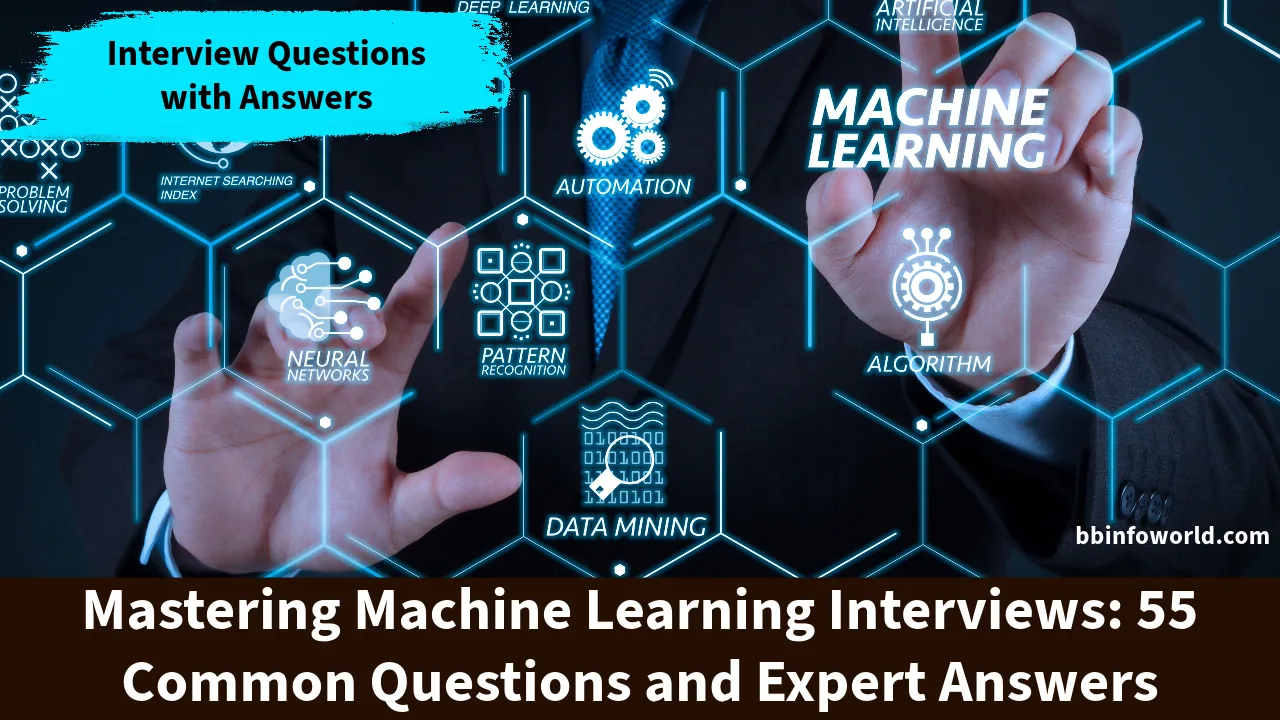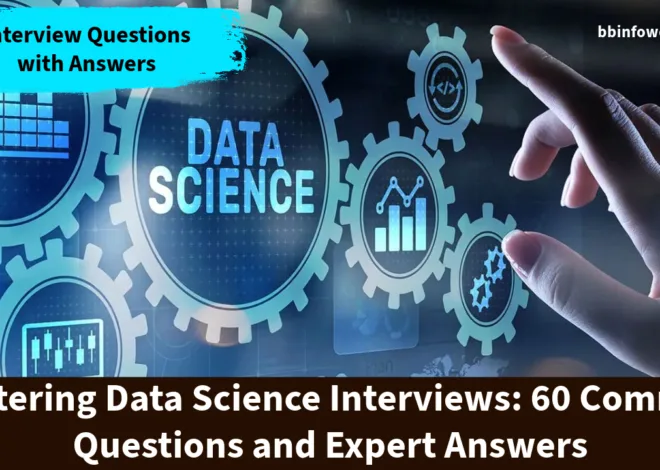
Mastering Machine Learning Interviews: 55 Common Questions and Expert Answers
Mastering Machine Learning Interviews: 55 Common Questions and Expert Answers
Machine Learning Fundamentals:
- What is Machine Learning (ML)?
- Answer: ML is a subset of AI that enables computers to learn and make predictions from data without being explicitly programmed.
- Name the three types of Machine Learning.
- Answer: Supervised Learning, Unsupervised Learning, and Reinforcement Learning.
- Explain Overfitting in ML.
- Answer: Overfitting occurs when a model learns the training data too well, including noise, and performs poorly on unseen data.
- What is the Bias-Variance Trade-Off in ML?
- Answer: It represents the balance between a model’s ability to fit training data (low bias, high variance) and its ability to generalize (high bias, low variance).
- What is Cross-Validation, and why is it important?
- Answer: Cross-Validation is a technique used to assess a model’s performance by splitting the data into training and testing sets multiple times to ensure reliable evaluation and prevent overfitting.
Supervised Learning:
- What is Supervised Learning?
- Answer: Supervised Learning is a type of ML where a model learns from labeled data to make predictions or classify new, unseen data.
- Give an example of a Supervised Learning task.
- Answer: Predicting house prices based on features like square footage and location.
- Explain the difference between Regression and Classification in Supervised Learning.
- Answer: Regression predicts continuous numerical values, while Classification predicts discrete class labels.
- What is a Decision Tree in ML?
- Answer: A Decision Tree is a tree-like structure used for classification and regression tasks, making decisions by recursively splitting the data based on features.
- What is a Confusion Matrix, and how is it used in classification evaluation?
- Answer: A Confusion Matrix helps evaluate the performance of a classification model by showing true positives, true negatives, false positives, and false negatives.
Unsupervised Learning:
- What is Unsupervised Learning?
- Answer: Unsupervised Learning involves algorithms learning from data without labeled outputs, typically for clustering or dimensionality reduction.
- What is Clustering, and give an example.
- Answer: Clustering is grouping similar data points together. An example is clustering customers based on purchase behavior.
- Explain Principal Component Analysis (PCA) in Unsupervised Learning.
- Answer: PCA is a dimensionality reduction technique that reduces the number of features while preserving essential information.
- What is Anomaly Detection in Unsupervised Learning?
- Answer: Anomaly Detection identifies unusual patterns or outliers in data, useful for detecting errors or anomalies.
- What is the difference between K-means and Hierarchical Clustering?
- Answer: K-means partitions data into K clusters, while Hierarchical Clustering creates a tree-like structure of nested clusters.
Reinforcement Learning:
- What is Reinforcement Learning (RL)?
- Answer: RL is a type of ML where agents learn to make decisions by interacting with an environment and receiving rewards or penalties based on their actions.
- Explain the concept of Markov Decision Processes (MDP) in RL.
- Answer: MDP is a framework used in RL to model decision-making problems as a sequence of states, actions, and rewards.
- What is the role of a Policy in RL?
- Answer: A Policy defines the strategy that an RL agent uses to make decisions in an environment to maximize cumulative rewards.
- What is Exploration vs. Exploitation in RL?
- Answer: Exploration is the agent’s strategy to try new actions to discover the environment, while Exploitation is choosing actions that the agent believes will maximize rewards based on current knowledge.
- What are the applications of Reinforcement Learning, such as in gaming or robotics?
- Answer: RL is used in autonomous vehicles, game-playing AI, recommendation systems, and robotics, among others.
Deep Learning:
- What is Deep Learning?
- Answer: Deep Learning is a subfield of ML that uses deep neural networks to automatically learn hierarchical features from data.
- Explain the role of an Activation Function in a neural network.
- Answer: An Activation Function introduces non-linearity to the neural network, allowing it to model complex relationships and make predictions.
- What is Backpropagation, and how is it used in training neural networks?
- Answer: Backpropagation is an algorithm used to update the weights of a neural network by minimizing the error between predicted and actual output during training.
- What is a Convolutional Neural Network (CNN), and what tasks is it well-suited for?
- Answer: CNN is used for image recognition and processing, utilizing convolutional layers to capture spatial patterns.
- What is Transfer Learning in Deep Learning?
- Answer: Transfer Learning involves using a pre-trained neural network as a starting point for a new task and fine-tuning it to adapt to the specific problem.
Natural Language Processing (NLP):
- What is Natural Language Processing (NLP), and what are its applications?
- Answer: NLP is a field of AI focused on the interaction between computers and human language. Applications include sentiment analysis, chatbots, and machine translation.
- What is Tokenization in NLP, and why is it important?
- Answer: Tokenization breaks a text into smaller units (tokens), such as words or sentences, a crucial step in text analysis.
- Explain the concept of Word Embeddings in NLP.
- Answer: Word Embeddings are vector representations of words that capture semantic relationships, enabling machines to understand language.
- What is a Recurrent Neural Network (RNN) in NLP?
- Answer: RNN is a type of neural network for processing sequential data, maintaining a hidden state to capture information from previous time steps.
- What is the Transformer architecture in NLP, and why is it significant?
- Answer: The Transformer architecture revolutionized NLP with self-attention mechanisms, leading to models like BERT and GPT.
Computer Vision:
- What is Computer Vision, and what are its real-world applications?
- Answer: Computer Vision interprets and understands visual information from images or videos. Applications include facial recognition and autonomous vehicles.
- What are Convolutional Layers in a CNN, and how do they work?
- Answer: Convolutional Layers apply filters to images to capture features like edges or textures, enabling the network to learn hierarchical representations.
- Explain Object Detection in Computer Vision.
- Answer: Object Detection identifies and localizes objects in images, often using bounding boxes.
- What are Image Segmentation techniques used for in Computer Vision?
- Answer: Image Segmentation divides an image into meaningful segments or regions, useful for tasks like medical image analysis.
- How does Optical Character Recognition (OCR) work, and what are its applications?
- Answer: OCR technology converts printed or handwritten text into machine-readable text, used for digitizing documents and reading license plates.
AI Ethics and Bias:
- What is AI Bias, and why is it a concern in AI development?
- Answer: AI Bias occurs when models produce unfair or discriminatory results due to biased training data, raising concerns about fairness and equity.
- How can AI Bias be mitigated, and what best practices should be followed?
- Answer: Mitigation involves diverse and representative training data, regular audits, and transparent model design.
- What are the ethical considerations when deploying AI systems in real-world scenarios?
- Answer: Ethical considerations include transparency, accountability, fairness, and addressing potential societal impacts.
- What is Explainable AI (XAI), and why is it important for AI transparency?
- Answer: XAI aims to make AI models and their decisions understandable and interpretable by humans, enhancing transparency and trust.
- What is AI’s role in addressing global challenges, such as climate change and healthcare?
- Answer: AI can contribute to addressing global challenges by optimizing resource allocation, analyzing data for insights, and supporting decision-making.
AI Tools and Technologies:
- What is TensorFlow, and how is it used in AI and Deep Learning?
- Answer: TensorFlow is an open-source ML framework developed by Google, widely used for building and training deep neural networks.
- Explain the role of PyTorch in AI research and development.
- Answer: PyTorch is a popular deep learning framework known for its flexibility and dynamic computation graph, favored by researchers and developers.
- What are neural network frameworks like Keras and Fast.ai used for?
- Answer: Keras and Fast.ai are high-level APIs built on TensorFlow and PyTorch, respectively, designed to simplify neural network development.
- What is the role of cloud-based AI platforms like AWS, Azure, and Google Cloud in AI development?
- Answer: Cloud-based AI platforms provide access to scalable resources, pre-trained models, and AI services for developing and deploying AI applications.
- What is the impact of quantum computing on AI, and how are they related?
- Answer: Quantum computing can accelerate AI by significantly speeding up complex computations, benefiting optimization and machine learning tasks.
AI in Industry and Research:
- How is AI used in the healthcare industry, and what benefits does it offer?
- Answer: AI aids in diagnosis, treatment planning, drug discovery, and patient monitoring, improving accuracy and efficiency.
- What role does AI play in the financial sector, particularly in areas like fraud detection and trading?
- Answer: AI is crucial for detecting fraudulent activities, automating trading strategies, and risk assessment in financial services.
- How does AI contribute to the automotive industry and autonomous vehicles?
- Answer: AI is central to the development of autonomous vehicles, enabling tasks like object detection, path planning, and decision-making.
- What is AI’s impact on e-commerce, including personalized recommendations and supply chain optimization?
- Answer: AI enhances the customer experience in e-commerce through personalized product recommendations and optimized inventory management.
- How is AI used in scientific research, such as drug discovery and climate modeling?
- Answer: AI accelerates scientific research by analyzing vast datasets, simulating complex systems, and predicting outcomes in fields like drug discovery and climate science.
AI and Future Trends:
- What are some emerging trends and challenges in AI, such as AI ethics and explainability?
- Answer: Emerging trends include AI ethics, explainable AI (XAI), AI in edge computing, AI democratization, and AI-powered healthcare innovations.
- What is the concept of AI democratization, and why is it important?
- Answer: AI democratization aims to make AI accessible to a broader range of people and organizations, fostering innovation and inclusivity.
- How is AI used in natural disaster prediction and response, and what impact can it have?
- Answer: AI assists in predicting and mitigating natural disasters by analyzing environmental data and improving disaster response.
- What are the ethical considerations of using AI in warfare and autonomous weapons systems?
- Answer: Ethical concerns include the potential for AI to be used in lethal autonomous weapons and the need for international regulations.
- What are some potential limitations and challenges in AI research and development, such as data privacy and bias?
- Answer: Challenges include addressing AI bias, ensuring data privacy, managing the environmental impact of AI training, and ethical concerns related to AI deployment.
These 55 Machine Learning interview questions and answers cover a wide range of topics, from fundamental concepts to advanced techniques and ethical considerations. Depending on the specific job role and company, you may encounter questions that focus on particular aspects of Machine Learning or AI development.



